Ministry of Science & Technology
Ionospheric based monitoring of large earthquakes – a plausible space based proxy to derive the seismic source characteristics
प्रविष्टि तिथि:
06 APR 2020 3:25PM by PIB Delhi
Scientists of Indian Institute of Geomagnetism (IIG) an autonomous institution of the Department of Science and Technology have extensively studied the signatures of recent large earthquakes into the ionosphere with an ambitious aim to derive the seismic source characteristics from the ionosphere.
While studying the 25 April 2015 Nepal earthquake, Mr. Sunil A. S, a PhD scholar working with Dr. Mala S. Bagiya, scientist at IIG, noticed that the spatial distribution ofnear field co-seismic ionospheric perturbations (CIP) associated with this event could reflect well the ground deformation pattern evolved around the epicentre. These CIP were derived using the Global Positioning System (GPS) measured Total Electron Content (TEC). The CIP distribution was estimated at ionospheric piercing point (IPP) altitude.
So, the characteristics of CIP could always be directly associated to the tectonic forcing? Mostly yes, provided the effects of non-tectonic forcing mechanisms which are operative at ionospheric altitudes are favourable. The spatial/azimuthal distribution of near field CIP associated with Mw 7.8 Nepal earthquake, which could successfully be linked to the co-seismic crustal deformation, is explained as the combined effect of tectonic forcing manifestations and non-tectonic forcing mechanism of geomagnetic field-acoustic wave coupling.
As part of the interdisciplinary program ‘Coupled Lithosphere-Atmosphere- Ionosphere-Magnetosphere System (CLAIMs)’ of Indian Institute of Geomagnetism funded by DST the research focused on energy transfer to the atmosphere during solid Earth processes such as earthquakes as well as tsunamis.
In general, the Earth crust uplift during any earthquake produces compressional (i.e. pressure) waves in the overlying atmosphere. These waves propagate upward in the region of exponentially decreasing atmospheric neutral density, and thus, its amplitudes increase with atmospheric heights. On arrival at ionospheric heights, the waves redistribute ionospheric electron density and produce electron density perturbations known as co-seismic ionospheric perturbations (CIP). The thrust earthquakes induce significant crustal uplift, while the strike-slip event mostly deforms the crust horizontally.Various ionospheric sounding techniques can be used to study the CIP characteristics. However, the TEC derived from Global Navigation Satellite Systems (GNSS) gives large spatial and temporal coverage over seismic source region,” the scientists explained.
“Evolution of seismic/tectonically induced ionospheric perturbation is highly controlled by the non-tectonic forcing mechanisms of satellite geometry, geomagnetic field-acoustic wave coupling and the ambient ionization density of ionosphere. The effects of these non-tectonic forcing mechanisms at ionospheric altitudes are quantified based on the in-house developed acoustic ray tracing model,” they added.
The scientists also successfully associated the observed ionospheric disturbances during a seismic event exclusively to the event by studying the ionospheric variation during the Indian Ocean doublet earthquake on 11 April 2012, a largest ever recorded strike-slip event (Mw. 8.6) that followed by a powerful aftershock of Mw 8.2, the highest ever recorded aftershock. These two earthquakes occurred in the same geographic region (epicentres apart by ~176 km) within a time delay of ~2 hours.
Analysing the ionospheric perturbations during another Nepal earthquake which occurred on 12 May 2015 (Mw 7.3), the researcher further demonstrated that how the non-tectonic forcing mechanisms influence the amplitude and horizontal propagation of CIPat IPP altitudes. They noticed that the evolution of near field CIP related with the Mw 7.3 Nepal earthquake was highly affected by the non-tectonic forcing mechanism of moving satellite geometry and as a result the CIP could not evolve in accordance with ground deformation pattern.
Moving a bit ahead from this, they attempted to observe the seismic source characteristic from the ionosphere during the massive Mw 7.8 Kaikoura earthquake 2016 which occurred in the complex multisegmented fault system between the Australia-Pacific plate boundary with a combination of vertical and differently oriented horizontal crust movements. Interestingly, the characteristics of CIP based on tectonic and non-tectonic forcing mechanisms revealed that the two distinct thrust zones over the rupture area resulted from the uplift with reinforcement of rotating horizontal motion from the epicenter acted as key tectonic sources for the peculiar distribution of CIP around the Kaikoura epicentre.
Thereby, by investigating the response of ionosphere to recent major earthquake events, the scientists at IIG have tried to derive the earthquake source parameters using seismic induced ionospheric perturbations by taking into consideration the non-tectonic forcing mechanisms.
The ionosphere is a highly dynamic region and the origin of any perturbations in ionospheric electron density can be traced to various origins either from above (e.g. solar, geomagnetic etc) or below (e.g. lower atmospheric, seismic etc) the ionosphere. This probes a major challenge while identifying the co-seismic ionospheric perturbations. Further, the manifestation of co-seismic ionospheric perturbations has to be seen in light of the prevailing non-tectonic forcing mechanisms.In this line, it is believed that the present extensive study may assist while designing a tool for the ionospheric based seismic source characterisation.

{Contact details
Mala Bagiya
Email: mala@iigs.iigm.res.in and bagiyamala[at]gmail[dot]com
Mob: 9773423820
Sunil Kumar
email: sunnil.as[at]gmail[dot]com
Mob: +91 9819645971}
*****
KGS/(DST)
(रिलीज़ आईडी: 1611606)
आगंतुक पटल : 1971